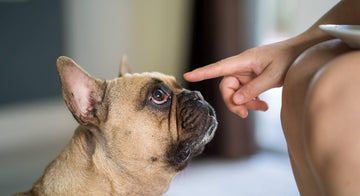
Dogs are some of the most intelligent animals. They often surprise us with their ability to understand cause and effect. While these traits can be harnessed for good, they can also lead to challenges when unwanted behaviors develop.
As dogs grow, many pick up bad habits, exhibiting a range of behavioral problems from jumping to inappropriate chewing and leash pulling. However, with some effort, you can guide your dog away from these destructive behaviors.
6 Common Bad Habits in Dogs and How to Deal With Them
As a provider of indoor grass potty pads for dogs, Gotta Go Grass® shares some strategies to untrain these common dog behavior problems.
Jumping
Jumping is an attention-seeking behavior in dogs that can be perceived as aggressive or simply annoying to some. It can also lead to accidents or injuries, particularly with children or the elderly. Untrain jumping by greeting your dog calmly to avoid overexcitement. When they try to jump, turn your back or ignore them to discourage the behavior. You can also command them to sit instead, redirecting their behavior positively. Over time, this teaches them to sit for attention instead of jumping.
Chewing
Chewing is a natural behavior, particularly for puppies during teething, but it can become destructive in adult dogs. Keep your possessions out of your dog's reach and provide appropriate chew toys instead. Additionally, make sure your dog receives enough exercise and mental stimulation. Teaching them the "leave it" command can also help them let go of items they shouldn't play with.

Counter-Surfing
Counter-surfing, or stealing food off the counter, is a common issue among dog owners. Dogs may use their snouts, front paws, or even jump to reach for food. Once rewarded, this behavior can be challenging to stop. To prevent it, avoid feeding your dog scraps from the counter. When preparing food or cleaning up, you can place your dog in a crate or use the "leave it" command if they attempt to grab food.
Leash Pulling
Pulling on the leash can make walking less enjoyable or unsafe for you and your dog. When out for a walk, avoid pulling your dog, as they will instinctively pull back. If your dog pulls, stop walking and call them back to your side. Consistency is key—mark good behavior with praise or treats. Practice in a location with fewer distractions to help your dog learn to pay attention to you, regardless of the situation.

Barking
Excessive barking can be a concern, particularly in apartments where neighbors are in close proximity. Address this by teaching your dog the "quiet" or "enough" command and using it calmly when barking starts. It's also important to understand and address the underlying cause of why dogs bark. It could be due to boredom, fear, or a need for more exercise. It can also be because they feel intimidated by other dogs in your household. If the barking is attention-seeking behavior, avoid reinforcing it by giving attention when they bark.
Peeing in the House
Dogs peeing indoors can lead to unsanitary conditions, furniture damage, and unpleasant odors. This behavior is often due to incomplete house training or territorial marking, and reinforcing potty training is crucial to address it.
If you live in a city or have limited access to the outdoors, solutions like Gotta Go Grass® pads offer a more acceptable indoor bathroom option. These grass pee pads for dogs can also help reinforce good bathroom habits. Additionally, it's important to consult your vet to rule out medical issues, stress, or anxiety that may contribute to this behavior.

Understanding Bad Dog Behavior in Dogs and Why They Occur
A dog's bad behaviors often stem from an underlying issue, which can include boredom, accidental encouragement, or a medical condition.
Boredom
Dogs can become bored without enough exercise or mental stimulation, leading to behaviors like excessive barking, chewing, or digging. Exercise helps release energy so make sure your dog gets enough walks and playtime to combat these behaviors. You can also provide mental stimulation with activities like treat puzzles or teaching them new tricks. If your dog has specific natural tendencies, such as digging, consider redirecting them to a preferable outlet, like a sandbox, for digging up toys.
Accidental Encouragement
Reinforcing undesirable behaviors can inadvertently contribute to a dog's actions. For example, allowing your dog to jump on you may encourage them to do the same to others. Giving in to begging or sneaking scraps from the table can reward this behavior. Similarly, playing with your dog when they bark to say they want to play teaches them that barking gets your attention.
Address these behaviors by retraining your dog and yourself. Consistency is key, so everyone in the household should be involved. Avoid inadvertently rewarding bad habits and correct negative behavior promptly and positively to help your dog understand the connection between their actions and your response.
Medical Issues
As dog owners, you should be aware that medical conditions can sometimes manifest as behavioral issues in dogs. For example, sudden frequent urination can indicate a medical problem like a bladder infection. In such cases, it's essential to consult your veterinarian for a proper diagnosis and treatment.
Saying, "No!" Won’t Cut It
Understanding why your dog behaves a certain way is key to addressing and preventing unwanted behavior. While our instinct may be to say "no" when our canine friends misbehave, this approach is ineffective. Saying "no," no matter how firmly or loudly, fails to provide guidance to your dog on what is expected. Moreover, relying on intimidation can have negative consequences, potentially damaging your relationship with your dog or encouraging them to hide their bad behavior.

Takeaway
So, how do you get a handle on your dog's conduct?
Addressing and correcting bad dog behavior requires a thoughtful approach. Many dog owners find success by understanding the underlying reasons behind their dog's behavior. Once you've identified the cause, you can then work on solutions. Consistency, positive reinforcement, and patience are key to changing your dog's behavior. Remember to reward desired behaviors and redirect their attention when necessary. Additionally, if you're struggling, you can always seek help from a professional, such as enrolling your dog in an obedience class or consulting with your vet.
By approaching behavior correction with patience, love, and care, you can strengthen your bond with your dog and guide them to become better.




